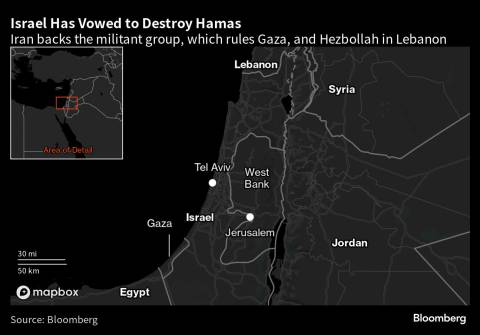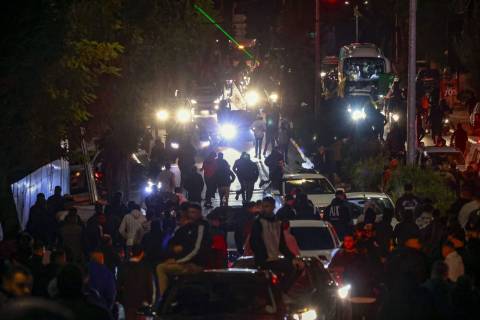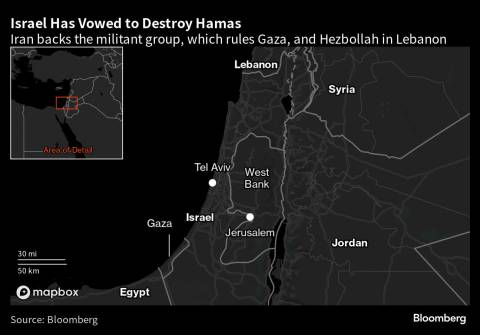(Bloomberg) -- Israel and Hamas resumed their war in the Gaza Strip on Friday morning after a week-long truce ended with the two sides failing to agree on the release of more hostages held by the militant group.

Israeli jets struck Hamas targets in Gaza soon after the cease-fire finished at 7 a.m. local time. The army also dropped leaflets on southern parts of the enclave, including around the city of Khan Younis, telling people to evacuate and signaling an expansion of Israel’s ground offensive beyond the north.

Dozens of rockets were fired at Israel, mainly from Gaza and injured five soldiers, according to the military.

The warring sides traded accusations about the breakdown in the truce. Israel said Hamas, designated a terrorist group by the US and European Union, didn’t free all the kidnapped women it promised to in the latest group to be released. It added that Hamas had violated the agreement by firing missiles at Israel.
The Palestinian Islamist group accused the Israeli government of refusing all its hostage-exchange offers on Thursday night.
The escalation of violence cut short the first pause since the war erupted on Oct. 7 with Hamas’s devastating attack on southern Israel. The truce led to dozens of hostages being freed and Israel releasing jailed Palestinian women and minors.
Hamas killed 1,200 people in its attack and took around 240 back into Gaza. More than 15,000 Palestinians have died since Israel began retaliatory airstrikes and the ground assault, according to the health ministry in the Hamas-run territory.
Qatar, the main mediator in the negotiations between Israel and Hamas, said it hopes to broker another pause.
Under the cease-fire, Hamas freed around 10 hostages each day and Israel let roughly 30 prisoners out of jail. Hamas and other militant groups are thought to still be holding around 130 people in Gaza, though it’s unclear how many are soldiers and how many have died.
Markets were largely steady after fighting restarted, with gold — a key asset for investors hedging against geopolitical strife — little changed at $2,037 an ounce as of 1:20 p.m. in London.
US Secretary of State Antony Blinken was in Tel Aviv when the cease-fire ended. He left shortly after as scheduled. On Thursday, he told Prime Minister Benjamin Netanyahu that the “massive loss of civilian life” in northern Gaza — where Israeli ground forces are concentrated — must not be repeated in the south.
Israel Resumes Airstrikes in Gaza After Truce Lapsed: TOPLive
It’s widely expected that the Israel Defense Forces will next send troops to that part of the strip. The bulk of Gaza’s roughly 2.3 million inhabitants have fled there since early October to escape fighting in the north.
Despite the increased pressure on Israel, the US hasn’t threatened to attach conditions to its military and financial assistance, according to a senior State Department official, who asked not to be named.
The US has, however, reiterated to Israel that it’s ready to ban Jewish settlers in the West Bank who have engaged in violence against Palestinians from getting visas for America, the official said.
The Gaza health ministry said 32 people were killed and dozens wounded within three hours of hostilities restarting, with many children and women among the casualties.
“Negotiations took place throughout the night to extend the truce, during which the movement offered to exchange prisoners and the elderly,” Hamas said in an earlier statement. “It also offered to hand over the bodies of those killed and detained as a result of the Israeli bombing.”
The cease-fire began on Nov. 24 after fraught negotiations involving Egypt and the US as well as Qatar. It was extended twice, the last occasion being on Thursday morning, minutes before the deal was set to expire.
Qatar reiterated calls for Israel to allow more aid into Gaza from Egypt. The United Nations says the humanitarian situation in the densely-packed strip is “catastrophic” and its civilians are in dire need of more food and medicine.
Netanyahu Defiant
Netanyahu and other Israeli politicians had consistently said the war would resume at some stage and the truce would not become permanent.
“Our forces are charging forward,” Netanyahu said on Friday. “We continue to fight with all our might until we achieve all our objectives: the return of all our hostages, the elimination of Hamas, and ensuring that Gaza will never again pose a threat to Israel.”
Saudi Arabia Offers Iran Investment to Blunt Gaza War
In addition to dropping leaflets in Arabic on southern Gaza, the IDF also said it would release a map for residents that would divide the whole territory into small zones. The army said it will issue instructions for each zone so residents know whether they need to leave their location.
The new round of hostilities will renew fears that the war could spread. Iran, which backs Hamas and Lebanon-based Hezbollah, blamed Israel and the US for the truce ending.
“Political and legal responsibility for the continuation of the aggression” lies with them, the Iranian foreign ministry said on X.
Escalation Fears
Tehran has for weeks warned of the risk of a broader conflict in the Middle East. Hezbollah is already involved in near-daily skirmishes with Israeli forces, while the Houthis in Yemen have fired missiles at Israel, most of which have been intercepted. The group seized an Israeli-owned cargo ship last month that it’s still holding.
On Friday, Israel flew reconnaissance aircraft over Lebanese border towns, according to the Arab nation’s media. The IDF said it intercepted a drone that crossed Israel’s northern border from Lebanon.
Still, the conflict’s largely been contained to Gaza for now, with the US and others warning Iran and its proxies against any major escalations.
British Prime Minister Rishi Sunak, shortly after the cease-fire ended, called for “sustained humanitarian pauses” in Gaza. He will discuss the crisis with Middle Eastern leaders at the COP28 climate summit in Dubai on Friday.
“We’ve been consistent that we want to see sustained humanitarian pauses so that more aid can get in to the people of Gaza but also the hostages can come out,” he told reporters in Dubai.
--With assistance from Omar Tamo, Roy Katz and Gwen Ackerman.
(Updates throughout.)
More stories like this are available on bloomberg.com
©2023 Bloomberg L.P.
Author: Fares Akram, Courtney McBride and Roy Katz
